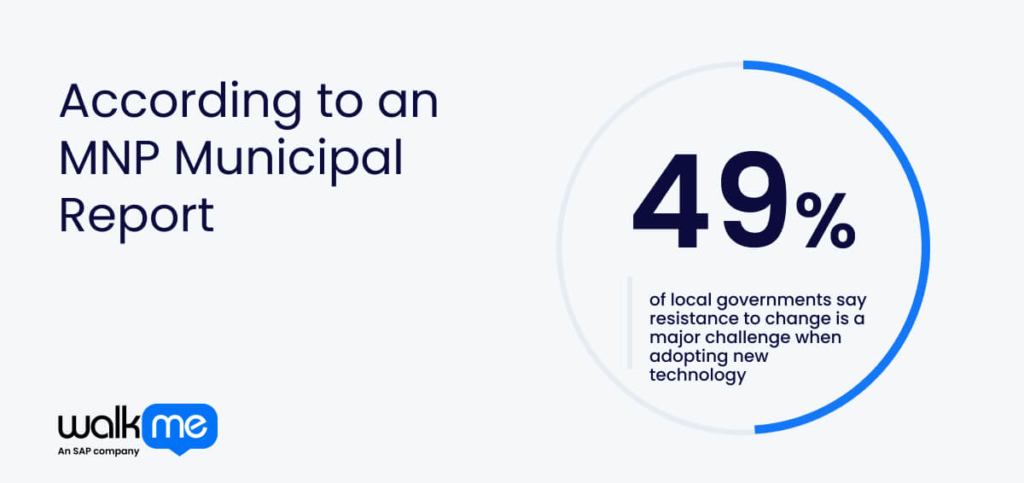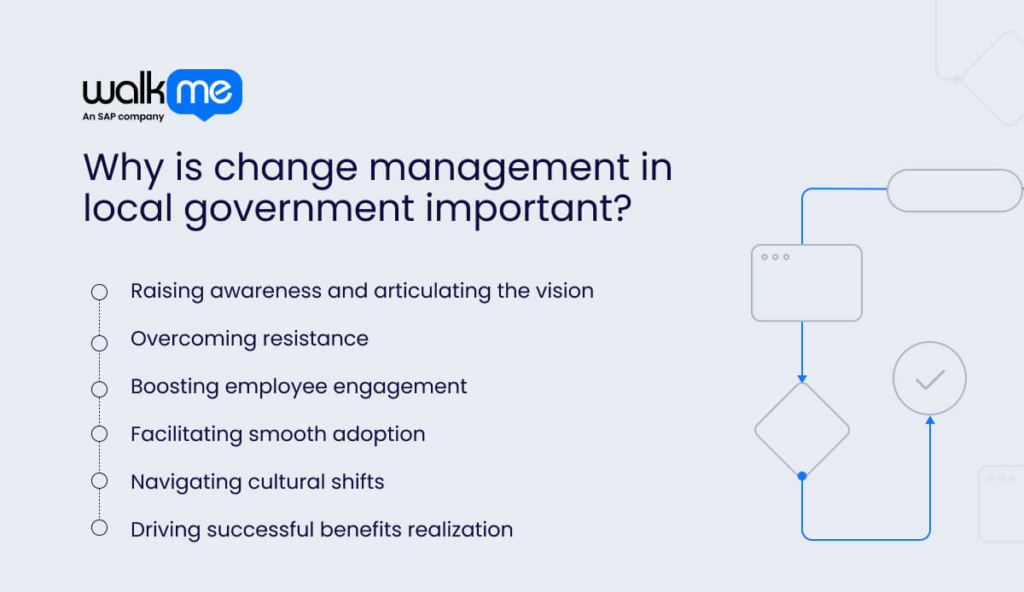The central government operates through rigid bureaucracies, enforcing policies at a national scale.
Local government, however, deals directly with communities, making decisions on housing, transport, and public services. This proximity means change management in local government requires flexibility, responsiveness, and engagement with residents.
Unlike central agencies, local governments must balance political pressures, budget constraints, and public trust. Effective change ensures smoother policy shifts, better service delivery, and community support.
According to an MNP Municipal Report, 49% of local governments say resistance to change is a major challenge when adopting new technology.

Governments must promote adaptive leadership, involve stakeholders early, and build strategies that reflect local needs to succeed. Achieving this while maintaining transparency and accountability is easier said than done.
This article explores change management in local government, why it’s important, how to align it with local government goals, and how to prepare employees for change.
What is change management in local government?

Change management in local government is the process of planning, implementing, and adapting to new policies, technologies, or ways of working.
Local councils deal directly with communities, so any change—like moving services online or updating public transport—needs to be practical and easy to follow.
For example, if a town introduces digitized parking permits, staff and residents need guidance on how to use the new system. Without clear intent, confusion can slow progress and digital adoption.
Change management in local government means training staff, keeping the public informed, and handling concerns early. When done well, it helps improve services without hindering the people they serve.
Why is change management in local government important?
For many years, change management has been a central business pillar that has helped companies transition to digital workflows, restructure teams after mergers, and adopt new customer experience models without disrupting operations.
Now, change management is impacting governments more than ever as they embrace digital innovation, improve public services, and navigate shifts in policies and regulations.
We’ve broken down the importance of change management in local governments into the following key points:
Raising awareness and articulating the vision
Raising awareness and sharing the vision helps people understand why changes are needed in local government. When leaders explain what’s changing and why, employees are more willing to support it. This alignment builds support, reduces confusion, and creates a smoother, more successful transition.
Overcoming resistance
Resistance can slow progress in local government by creating delays in adopting new systems or policies. Employees might avoid using new digital tools, while citizens may ignore updated services. This can lead to disorder, errors, and frustration. Overcoming resistance to change helps ensure smoother transitions and faster implementation of improvements.
Boosting employee engagement
A city council implementing a new digital platform for tracking public service requests is an example of boosting employee engagement. When employees are given proper training, involved in testing, and their feedback is considered, they feel more invested in the system. This leads to quicker adoption, fewer mistakes, and improved citizen-focused services.
Facilitating smooth adoption
Facilitating smooth adoption in local government means ensuring employees and citizens can easily use new systems. For example, if a town updates its online permit system, offering simple training, clear guides, and help when needed helps everyone feel comfortable using it. This makes the change easier and less stressful.
Navigating cultural shifts
Navigating cultural shifts in local government means helping staff and citizens adjust to new ways of working or interacting. For example, people might need time to adapt if a town switches from in-person services to digital ones. Change management encourages participative leadership, open communication, and learning to make this easier for everyone.
Driving successful benefits realization
Driving successful benefits realization in local government means making sure planned improvements work. For example, when introducing a new digital system, it’s important to track how much it improves services, saves time, or cuts costs. Change management helps ensure these benefits are clear, achievable, and last over time.
How to align change management with local government goals
Change management was initially developed with businesses in mind, but over the years, it has been applied to many other areas of improvement.
Understanding how to align change management techniques with local government goals is crucial for creating a framework that speaks to stakeholders and community members.
Let’s take a closer look at how to align change management with local government goals:
Connect change initiatives to strategic goals
Local governments have various strategic goals often derived from directives set by the central government. They must follow specific guidelines and frameworks while adapting change initiatives to meet local needs and priorities, ensuring alignment with broader national objectives.
For local governments to make meaningful progress, they need to connect their change efforts with the goals set by central authorities. The challenge is making sure these broad goals match what local communities need. Linking change initiatives to clear objectives means local governments can ensure their efforts are effective and beneficial for maximum impact.
Involve stakeholders from the start
Involving stakeholders is key to aligning change management with local government goals. When local governments include employees, community members, and other important groups early on, they ensure everyone’s needs and concerns are heard. This builds trust and increases the chances of successful policy implementation.
For example, if a city plans to upgrade its public transportation system, involving local residents and workers in the planning phase can help identify challenges, gather feedback, and find adequate solutions. This ensures that change aligns with the community’s real needs, creating a more proactive transformation.
Communicate openly and consistently
Clear and regular communication is vital in local government change management. When staff, residents, and stakeholders are kept informed, it reduces confusion and builds necessary trust. Regular updates help everyone stay on the same page and address concerns early.
Open communication also allows smoother transitions, as people feel more involved and confident in the changes around them. Transparency throughout the process makes it easier for local governments to manage new systems and adjustments while keeping the community engaged and supported.
Create a customized change management plan
A customized change management plan for local government must address the community’s unique needs and the project’s specific objectives. Start by identifying the required changes and their impact on services or processes. Engage local employees, residents, and community leaders, gathering their input and concerns.
Provide periodic updates about the progress and any adjustments being made. As challenges arise, adjust the plan to fit the circumstances, ensuring the change is manageable and relevant. A flexible approach helps minimize disruption and keeps the community and stakeholders informed.
Track progress and adjust as needed
Tracking progress and making adjustments is a natural part of managing change in local government. Change doesn’t happen in a straight line, and challenges often emerge once the process begins. It’s essential to regularly evaluate how well the new systems or policies are performing and whether they’re meeting community needs.
Gathering input from staff and citizens helps identify any problems early. Rather than sticking rigidly to a plan, being open to making changes based on real-time feedback shows adaptability and commitment to improvement. This ensures the goals are met and the community feels confident in the process.
How to prepare local government workers for change management
One of the most important tasks for local government leaders introducing change management initiatives is equipping their workforce with the knowledge and skills to adapt.
Change management preparation isn’t a one-time fix or a quick solution. It requires ongoing effort, ensuring that employees understand the change and are supported through it with the resources and training needed to thrive in an environment in constant flux.
With that in mind, let’s take a closer look at how to prepare government workers for change management:
Evaluate organizational readiness
Before change can take hold, leaders need a sharp understanding of where their organization stands. This means assessing existing processes, identifying roadblocks, and gauging employee sentiment. Is there resistance? Are there skills gaps? Without these insights, change efforts risk failing before they start.
Set a clear vision for change
Workers won’t buy into change unless they know where it’s heading. A vague idea of improvement isn’t enough—local government leaders must articulate exactly what’s changing, why, and how it impacts daily work. This vision must go beyond policy documents and jargon. It needs to be relatable, answering the question: “How does this make my job easier and my community better?”
Create a comprehensive change plan
Change without structure leads to confusion. A solid plan must detail every stage, from initial communication to long-term reinforcement. It should break down responsibilities, outline timelines, and anticipate setbacks. Most importantly, it must be flexible enough to adapt when reality doesn’t match expectations. Local governments often deal with shifting policies and public pressures, so rigidity can backfire.
Establish a network of change champions
A single leader pushing change isn’t enough. Real progress comes from within—through employees who advocate for and guide their peers. These champions don’t need to be senior managers. Often, the most influential figures are those on the front lines who colleagues trust. Local governments should identify staff members who understand the big picture and day-to-day operations.
Empower leaders at every level
Top-down directives rarely succeed in local government. Middle managers and frontline supervisors are crucial in translating change into action. Yet, they’re often left out of the conversation until problems arise. To avoid resistance, leadership must provide these figures with clear guidance, authority, and a platform to voice concerns. When department heads are involved early, they can address skepticism, provide real-world feedback, and act as role models.
Develop a digital skills and training program
Technology is at the heart of modern local government, but new tools are only as effective as those using them. Training can’t be an afterthought or a one-time event—it must be continuous, practical, and tailored to different roles. Clerks managing digital records, field workers using mobile reporting apps, and planners navigating GIS software all have unique learning needs.
Communicate effectively and regularly
Silence breeds uncertainty. When change happens, gaps in communication create frustration, rumors, and resistance. Leaders must speak openly through emails, memos, direct conversations, town halls, and informal check-ins. Messages should be clear, relevant, and consistent, ensuring that employees aren’t left guessing about what’s coming next. Notably, communication should be two-way.
Sustain and reinforce the change
Change isn’t over once a new policy, system, or process is in place. Without reinforcement, old habits creep back in, and momentum fades. Leaders must make change stick by embedding it into daily workflows, holding teams accountable, and celebrating progress. Public recognition of success, ongoing training, and adapting policies based on real-world feedback all play a role.
How to ensure lasting change in local government
Creating lasting change in local government is easier said than done.
With governments coming and going and priorities constantly shifting, it’s difficult to design a change management lifecycle that satisfies everyone.
However, building robust strategies that feed into change management frameworks can empower both employees and leaders throughout the learning and change process.
Successful initiatives should be flexible enough to accommodate new policies while maintaining continuity.
When leadership transitions occur, employees who have been part of well-managed change efforts are more likely to provide valuable guidance. They understand the systems in place, can help new leaders navigate shifts, and contribute to a smoother transition.
FAQs
They should communicate clearly, involve employees and residents early, and show real benefits. Regular updates, public meetings, and small wins help build trust. Being flexible allows changes to fit community needs, making them easier to keep over time.
Public employees put changes into action, help residents adjust, and give feedback on what works. When they are trained and involved, they make transitions smoother and prevent confusion. Their support helps make changes work well for everyone.
People resist change when they don’t understand it or feel left out. Governments can ease concerns by explaining changes clearly, listening to feedback, and making adjustments when needed. Training and open discussions help employees and residents feel more comfortable and willing to support new ideas.

